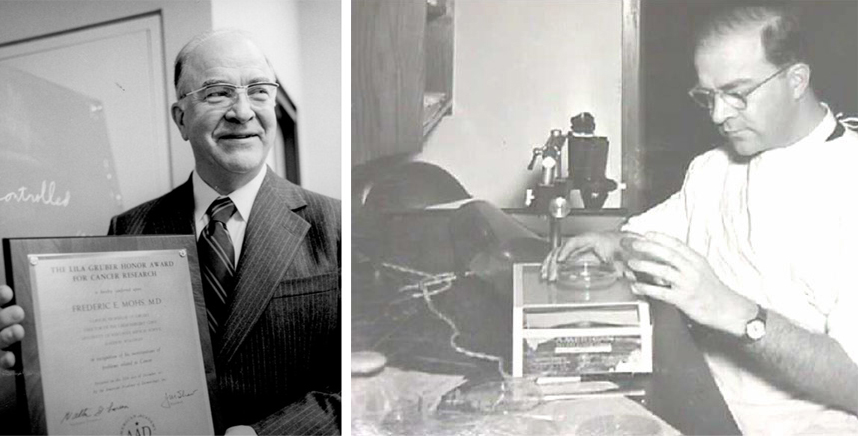History of Mohs Surgery
Mohs Micrographic Surgery is named after its founder and originator, Frederic E. Mohs, MD (1910-2002). As a medical student from 1929 to 1934, Dr. Mohs conducted cancer research projects while working for his mentor and zoology professor, Michael Guyer. Dr. Guyer was familiar with the preparation of frozen tissue for producing microscopic slides and had authored a book explaining how to harvest and process tissue for microscopic examination. The book focused on the need for examining, drawing and documenting discoveries that were made with the microscope.

These microscopic techniques were later used by Dr. Mohs to map out cancer around nerves, blood vessels, muscle and bone. The cancers he examined were removed by shave or saucerizing excision, a technique that removed cancer as a thin disc of tissue so that the tumor and the inflammatory white-cell infiltrate surrounding the cancer could be examined with the microscope.
After finishing medical school Dr. Mohs began his practice in a one-room clinic of the dermatology suite of the Wisconsin General Hospital in Madison, Wisconsin. The very first Mohs lab consisted of a student desk with a freezing microtome and a staining setup. Sections were processed in the same room where the surgeries were performed. Surgical pathologists and their residents processed the slides for Dr. Mohs, and if a nurse was needed, Dr. Mohs would borrow one from the emergency room. On June 30, 1936, Dr. Mohs treated his first patient, an individual with a squamous cell cancer of the lower lip.
After spending four years studying refining and perfecting his procedure, Dr. Mohs expanded his practice in 1940. Since his procedure involved more surgery than dermatology, his clinic was transferred to the department of surgery.
As time went by and the number of patients grew, so too did the amount of tissue for processing. Dr. Mohs placed a high priority on having good quality slides done in an expeditious manner.
The Mohs technician who is usually identified with Dr. Mohs is Bob Patnaude. Bob worked from 1946 until his first retirement in 1966, and then from 1974 until his real retirement in 1985. His job entailed assisting Dr. Mohs with his surgeries, many of which were in-house. At the time, walk-in patients were treated in the morning and afterwards, the larger in-house cases were done.
In 1953, Dr. Mohs accidentally performed a fresh tissue excision on a lower eyelid and was surprised with the excellent results. After this, he began to use fresh tissue excision for all his eyelid margin cases, as well as for small discrete cancers in other locations. After Dr. Theodore Tromovitch’s paper detailing microscopically controlled excision with fresh unfixed tissue was published, Dr. Mohs and most other chemosurgeons of the day began to use the fresh tissue technique almost exclusively. Patients were the primary beneficiaries of this change because they could now have their surgeries and closures in one visit on the same day, allowing for immediate reconstruction of the wound. This change eventually brought about a name change from Chemosurgery to Mohs (Micrographic) Surgery.
In the 1970s, specific machines called cryostats were developed to assist the process of freezing live tissue for examination under a microscope. Automatic tissue staining machines were added in the 1980s to assist clinics with the growing number of patients and tissue samples. Throughout all the technical improvements in devices and refinements of technique, the focal point–the color-coded mapping of excised specimens and their thorough microscopic examination–remains the defining characteristic of Mohs micrographic surgery to this day.
